No Results Found
The page you requested could not be found. Try refining your search, or use the navigation above to locate the post.
Rio Vista residents interested in learning sustainable ways of building and maintaining an edible, water-wise yard will get that chance in a series of three workshops at one Rio Vista residence. This marks the expansion of Sustainable Solano’s Sustainable Backyards program into Rio Vista.
The series of workshops, over three weekends in October, will create “Fortune’s Garden.” The yard will show what can be created from the blank slate of an empty yard in a new development to use water wisely while creating an ecosystem that is both beautiful and functional.
The Sustainable Backyard Program introduces the concept and practice of permaculture to Solano County. Permaculture is a sustainable design system stressing the harmonious interrelationship of humans, plants, animals and the earth. The core of permaculture is design and the working relationships and connections between all living things.
The program and the series of installations in Rio Vista are made possible by the generous support of the Solano County Water Agency.
Rio Vista Demonstration Food Forest Installation
10 am-4 pm on Oct. 5, 12 and 19
The address will be available to participants upon registering. Lunch will be provided by the homeowner at each workshop. Please bring hats, gloves, reusable water bottle and sunblock.
For more information and to register, visit SustainableSolano.org/events
(More details and direct registration links included below)
DAY 1: Saturday, Oct. 5 – Laying the Foundation
We will be laying down the foundation of this edible garden: digging on-contour swales, making berms, diverting the roof water and planting trees. Break ground with friends and neighbors and learn how to use water wisely while creating an environment where life-supporting plants thrive. This installation day includes a short lecture from Lauren Bennett, owner of Bay Wise Gardens, on how to build a food forest.
DAY 2: Saturday, Oct. 12 – Laundry-to-landscape greywater system
Greywater Action will be leading the workshop to teach hands-on how to install a simple laundry-to-landscape system in your own home. You will learn how to install a simple three-way valve in your laundry room, connect the pipe from your washing machine to your landscape, and how to prepare your landscape to receive the greywater. This installation day begins with a lecture about greywater.
DAY 3: Saturday, Oct. 19 – Learn to install a water-efficient in-line drip irrigation system and plants
We will add plants to the ecosystem as well as drip irrigation, and have an opportunity to see a dead, barren backyard transformed into a customized food forest based on permaculture design principles. This installation includes a short lecture from Lauren Bennett, owner of Bay Wise Gardens, on selecting plants and creating a custom design.
Topics Covered:
About Sustainable Solano
Sustainable Solano is a countywide nonprofit organization that is dedicated to “Nurturing Initiatives for the Good of the Whole.” The organization, now in its second decade, brings together programs that support and sustain one another and the Solano County community. Initiatives include sustainable landscaping, local food, resilient neighborhoods, sustaining conversations and community gardens.
For more information, email info@sustainablesolano.org or visit sustainablesolano.org
By Allison Nagel, Communications Manager

The Solano Local Food System Alliance held its first official meeting at the end of August to discuss how to foster a strong local food system within the county.
Though the Alliance is a new entity, its work grows out of the efforts of many Alliance members during the past two years as the Local Food Advisory Board. In that capacity, the group of leaders, including farmers, and those in private businesses, public agencies and local organizations, shaped the foundation of the tasks the Alliance will take on and address during quarterly meetings.
The advisory board’s work supported the vision to diversify, expand and safeguard a local, healthy food economy that will preserve farmland, its integrity and biodiversity in the county, and ensure food access for all our communities. The mission set before the Alliance is to do the work needed across stakeholders, organizations and agencies to create an environmentally sustainable, economically viable, socially just and equitable local food system in Solano County.
At the August meeting, Alliance members started the conversation and set goals toward accomplishing that mission. They discussed the challenge farmers face from the fees involved in selling their food at different venues, reviving marketing efforts around promoting food grown in Solano County, the need to gather better data about food grown and bought in the county and planning events that help promote local food, such as Bounty of Solano County, an event that would be held at the Solano County Fairgrounds to promote local growers and restaurants.
The Alliance received updates on ongoing efforts and discussed next steps.
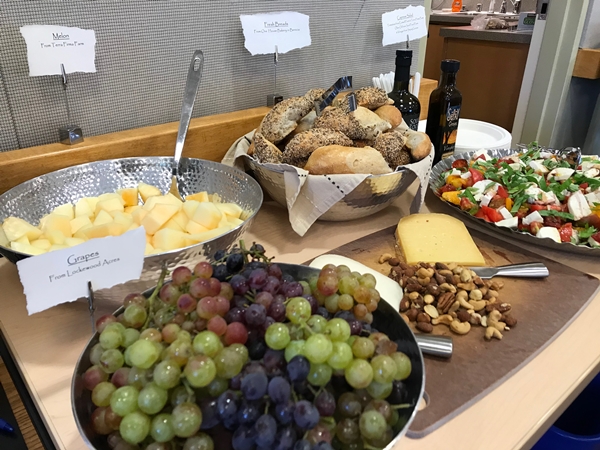
Alliance members enjoyed seasonal items from local farms during their meeting.
Sustainable Solano continues its efforts to build a network of institutional customers, whether healthcare providers, schools or other institutions, that will source more of their food from local farmers. Part of that project aims to educate the public on where the food is coming from — building stronger community awareness of local food and offering experiences that help build consumer preferences for local food. There was discussion of promoting a “5 by ’25” approach, which would encourage that institutional customers and individuals seek to spend 5% of their food spending on local food items.
In October, Alliance members will meet with each other and key community stakeholders and policymakers for intensive listening sessions. Those sessions are supported by tribal funding that targets systems change, allowing time to work together to suss out the vital components of creating change in the local food system. More direction and action items will come out of those meetings.
Action items to be revisited at the January Alliance meeting include:
August’s Alliance meeting included a presentation on best practices from Greenbelt Alliance’s Amy Hartman, who also sits on the Solano Local Food System Alliance.
She discussed the value of encouraging policy change, such as urging Solano County cities to allow urban agriculture (Vallejo is the only one that permits urban farms at the moment). She talked about framing such conversations around new uses, such as San Francisco’s classification of “neighborhood agriculture” and focusing on the benefits to public health and activating vacant lots.
Curious about the Solano Local Food System Alliance? Learn more about the USDA grant that led to the creation of the Alliance and find out more about the group’s work here.
By Sustainable Solano
This is an ongoing series profiling local farms that have Community Supported Agriculture (CSAs) available in Solano County. CSAs create a way for community members to buy a share of the harvest directly from local farmers. Customers pay a set amount and receive a box of seasonal produce or other farm products in return. Such arrangements help farmers receive a greater share of the money paid, bring customers fresh, local produce and promote health, community and the local economy.
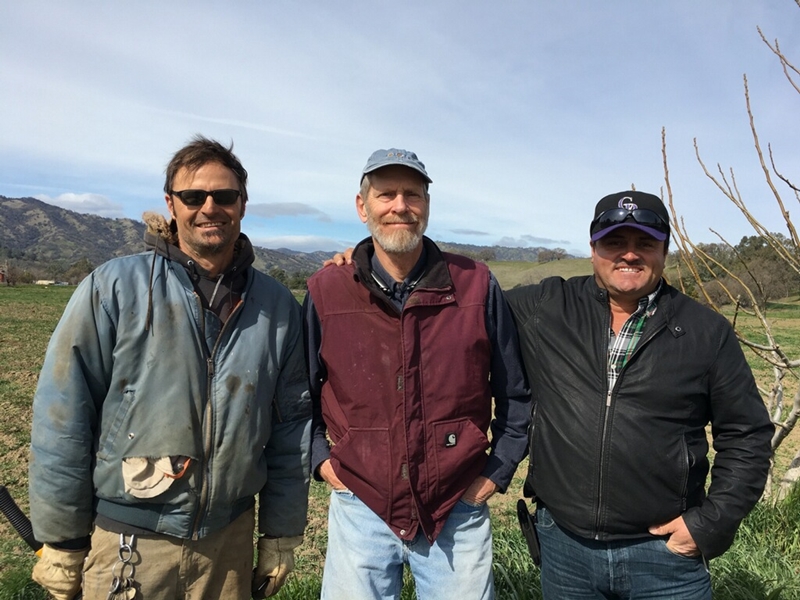
Terra Firma Farm is a certified-organic farm that has been growing fruits, nuts and vegetables year-round for more than 25 years and supports dozens of employees.
The farm started in 1984 when Paul Holmes and his friends started farming a few acres in the hills west of Winters under the name Sky High Farms. Paul was one of the founding members of the Davis and Berkeley Farmers Markets.
Eventually the farm name became Terra Firma, as Paul Underhill and Hector Melendez became co-owners. The acreage grew over the years as demand for local, high quality, organic produce rose, CSA Manager Alicia Baddorf said.
“The owners recognized the desire of city folks to reconnect with local farms and know more about the source of the food that they and their families were consuming,” she said.
The farm has offered a CSA for more than 15 years.
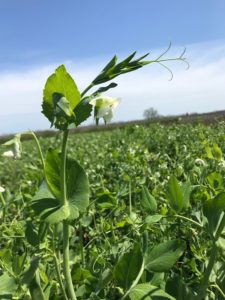
Below is a Q&A with Alicia about Terra Firma Farm:
When did you start offering a CSA? Why was it important to offer?
We started offering a CSA in 1994 at a single site in San Francisco’s Mission District. We were one of the earlier farms to offer a CSA program, feeling that it was important to bridge the gap between urban folks and the food chain.
Are there special perks for CSA members? Why do people tend to subscribe?
CSA members get to enjoy fresh, seasonal and local produce every week. Subscribers who pay a larger amount up front receive a bonus, and those who refer their friends receive a referral credit. People tend to subscribe because they are looking for a good source of fresh, local, quality fruits and vegetables. Many people also want to support a small farm that uses organic practices that align with their values.
What’s something that makes your farm stand out?
We are committed to providing sustainable employment and encouraging local economic development. We provide full-time, year-round employment for our workers. We employ roughly 10 times as many people per acre as most farms in our region. By selling, packing and delivering our products ourselves (adding value) we are able to offer a range of jobs that allow employees to move vertically as their careers progress.
Anything exciting on the horizon? What do you see happening and what do you want to see happen with interest in local food?
We are always adjusting our crop plan and working on a feedback loop. This year we have been working with Brad Gates of Wild Boar Farms, who is trialing a mix of his tomato varieties on one of our properties. He develops wacky and beautiful looking tomato varieties, so it has been exciting for us to learn about and harvest new varieties of tomatoes that add some flair to our mixes.
Anything else you’d like to add?
We are always looking to offer fruits and vegetables to more households in Solano County. If anyone is interested in hosting a pick-up site in exchange for a weekly box of produce, please contact me for more information: csa@terrafirmafarm.com
Terra Firma Farm has Solano County CSA drop sites at the Benicia CSA Center and near Orlando Court in Vacaville. Learn more about how to sign up here.
Find out more about local CSAs here.
By Gabriela Estrada, Solano Gardens Program Manager
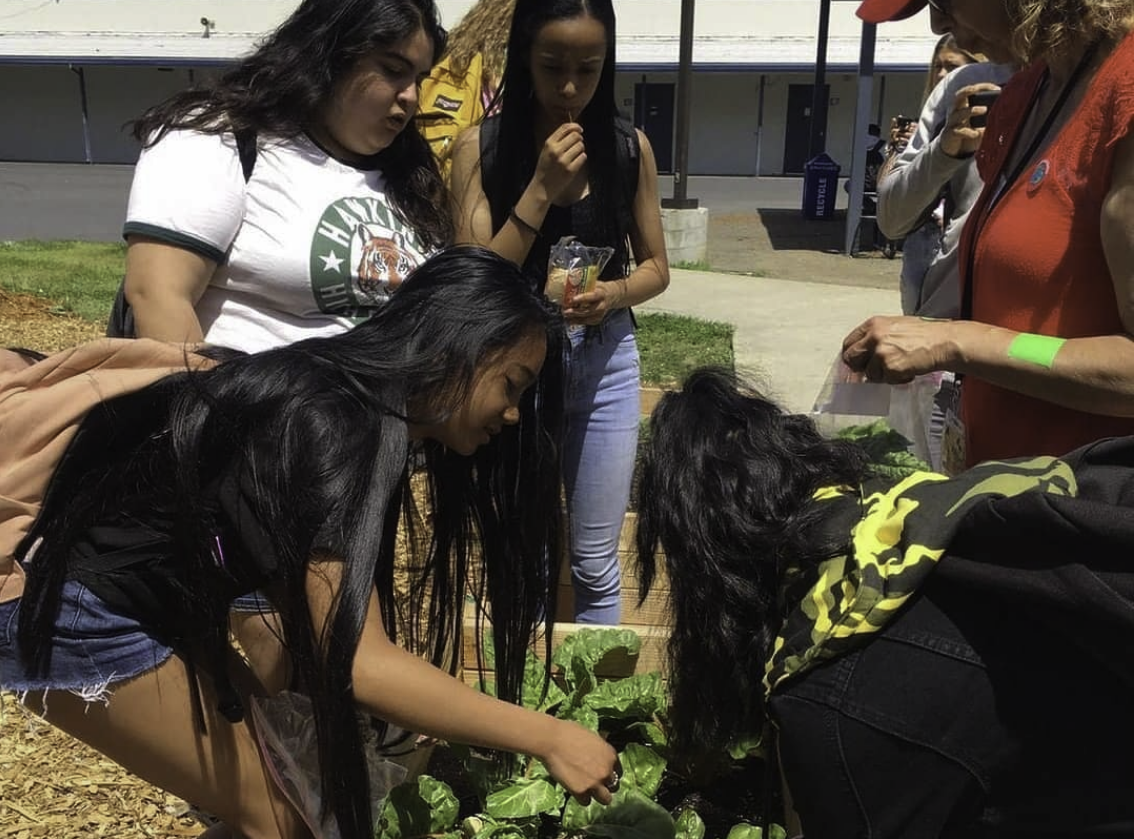
When people tell you it takes a village to create great things, believe them. They most likely understand that the world is a connected place and that nothing truly great ever gets accomplished in a vacuum. Solano Gardens, for example, was made possible with support from Solano County and the need for a model of community gardens in low-income communities that serve as a source of fresh produce, a hub of information and a place for building relationships.
From this source of funding, Jardin de la Esperanza (Garden of Hope) was developed. This garden at Armijo High School in Fairfield began with the dedication of a couple of teachers, a few wine barrel planters purchased by the principal and a passion for gardening and a desire to take learning beyond the classroom. They shared this with their students and created a garden club.
To announce this club, a banner was created and placed outside the school. This banner caught the eye of Jeff Barton, a longtime Sustainable Solano supporter and host of our Walk The Talk Workshops. Intrigued about this club, he walked into the school and shared information about permaculture, Sustainable Solano and that we were looking for a school to install a permaculture-based garden. Sylvia Herrera, English teacher and garden adviser, jumped at the opportunity, and like the force of nature that she is, began to move the project forward. We were then joined by Michelle Bolden, special education teacher and co-head of the garden club, English teacher Vanessa Willing-Sisi and Principal Sheila Smith.
The next steps involved getting on the same page about the kind of garden we wanted to create. We had a meeting with students who were interested in supporting the garden and the project. To make this garden something that fit the needs of people, we enlisted these students in supporting with the design, the needs and the overall implementation of the project.
Out of this meeting, the Get Fresh Crew was created: Sebastian, Flor, Valeria, Florence and Ana.
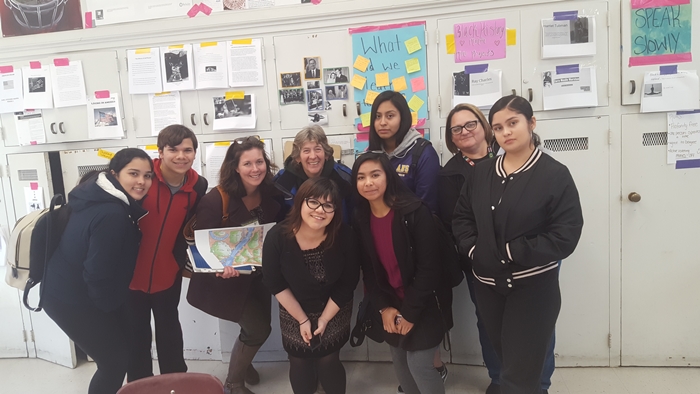
After a few meetings where we briefly discussed what we wanted and needed out of the garden, we created a design. This design took elements of permaculture, ideas from different students and from the Get Fresh Crew, and from our lead landscape designer, Kathleeen Huffman.
Then the physical work began! Sylvia, Michelle and Vanessa enlisted their students in the digging, sheet mulching and planting of the guilds. Woodshop teachers and their students also supported the project by building raised beds for the garden, and the art teachers and students began planning for a painted mural.
A week later, we had a garden! A garden that was created for students by students and whose produce will help support Armijo’s Pantry, a food pantry for Armijo families in need. It always amazes me what a few passionate people can do when they put their minds to it and the impact that they can create.
You can be part of this process. Interested in helping to create a new garden? Join us in installing a vegetable garden at Emmanuel Temple Apostolic Church in Vallejo on June 22.
Do you know a church, a private residence, a school or an apartment complex that has limited access to fresh produce and would benefit from a community garden? Fill out our Interest Form to tell us about it!
So what impact did the garden create? Check out the student insights here and in the videos below (scroll down to view).
To me the garden is a way for us as students to get involved in something that matters more than just our regular curriculum. The garden is not only a creative outlet for us as students, but it teaches us to appreciate the natural world around us. The garden represents a new venture into a more involved and natural community. In the future I envision the gardening not only continuing, but growing and thriving.
— Aaron R.
The garden has given my classmates and I the opportunity to get involved and give back to the environment. It also allowed us to gain knowledge and appreciate indigenous culture. It is a great way to get students involved and hopefully continue to nurture the garden for future Armijo students to enjoy. It’s also a great opportunity to inspire students and encourage them to become more involved with their community and show compassion for the environment.
— Mariah A.
The garden was a great opportunity for my class and I to create a beautiful way of giving back to the environment. It was great opportunity to learn about gardening and a welcome change from sitting all day long in a classroom. In the future, I envision the garden continuing to grow and being not just a beautiful sight to see while walking to class and an opportunity to learn about nature.
— Alexia C.
Rosemary, sage, and strawberry. With each new plant we add to our garden, we grow our appreciation of not only gardening, but indigenous culture. This garden has given me a moment of calm in the center of campus. I am inspired by the sweetness of our lemongrass to the sturdy miner’s lettuce, which withstands its tangled stems. Our trampled grass and cold concrete has metamorphosed into a vibrant display of our hard work and optimism— a lesson that I will never forget.
— Royce G.
Creating a garden is a very precise and skillful task that teaches indigenous knowledge. It shows the hard work that the student community has put in to better the society by promoting healthy and diverse fruits and vegetables. I can see future generations continue the tradition of cultivating our garden to learn about indigenous knowledge and the work behind how our food is grown.
— Stephen I.
I believe the garden is a great way to teach others about agriculture and indigenous culture. It also teaches other skills that aren’t (but should) be better promoted in schools such as healthy eating and survival skills. I hope it’ll expand and help unite all of Armijo.
— Florence T.
In the future I hope that the garden expands. I hope that the following generations appreciate it as much as some of us do. I learned by having a garden that it’s a way to bring people to work together as a community and a way to learn values.
— Juliza V.
The garden is a pretty cool concept to me because it symbolizes growth and balance. I think it is a nice opportunity for students to connect with nature and have a chance to be cultivators of a better future that depends on us, the students. I hope in the future the garden thrives and keeps growing as the peaceful mindset of the garden also grows.
— Juan D.
To me, the garden represents growth in our school. We are beginning to bring new opportunities to learn and expand the school’s knowledge. I hope that the garden continues to expand and even more people become involved. Having a garden teaches those working in it patience, care and commitment.
— Brianna V.
Working in the garden taught me about the different types of plants that grow natively in this area. Before I didn’t know what was imported and what was naturally grown here.
— Madelyn G.
My time in the garden has taught me new things about plants and their various uses that I wasn’t aware of. I envision the garden being full of life, with vegetables and fruits that will improve the nutrition in this school and show students some work ethic.
— Alvin A.
Being a part of the creation of the garden has been a great experience thus far. Shoveling, raking, watering the plants or simply doing WHATEVER IT TAKES has been great. Labor turned into competitions to see who could shovel more bark into the barrels. Since it is a part of our TOK curriculum related to indigenous knowledge, our class has been outside working on it for the past two weeks, making for a great time. In the next coming year, I hope for it to still be thriving and I hope for all the plants to be in good condition and well manicured. By having a garden, great responsibility skills are learned as it takes a lot of care to maintain the beautiful garden. All in all, I have really enjoyed my time in the creation of the garden!
— Alessio I.
To me, the garden seems to be one vision of what we at Armijo want to see in our future — growth — and how it portrays future aspects of beauty for our community. My understanding of the garden is that it is a community experience for the school that shows how the Fairfield and Suisun high school population can work together as a team to produce something not for material gain, but to show the indigenous knowledge our of area. Thus, as a constituent of this complex, yet miraculous process, I have been instructed and taken with me the abilities to sustain the environment by increasing the biodiversity of the garden and other important and sustainable processes in making a garden.
— Hezekiah B.
I love how the garden was nothing at first and became a big project that put all students to work and interacting with each other. The best part of building the garden was how all students put a little of something of theirs in the garden like ideas and thoughts.
— Lydia R.
Having a school garden means a lot to me because I was part of its creation from the very first beginning and it has really helped me develop some skills. It also has a metaphorical meaning for many students because it represents our growth and how we take care of ourselves; and I love that part. The best part of the garden was working with all the students and Sustainable Solano members to make things in the garden happen. I really hope the garden can help (in a physical and emotional way) and feed many people, and that future students make a good use of it. I wish all the best for it.
— Valeria G.
Having a school garden to me means good publicity for the school. The best part of the garden journey is being able to go outside.
— Isaiah P.
Having a garden at school means that we could educate the students on the how important nutrition is. The best part of the garden journey is seeing it all come together with the trees and plants. I envision the garden being very well developed. I can see the trees getting bigger and actually producing fruits and vegetables.
— Zaria R.
Having a garden at school serves as an element that stands out. It has been a rarity, since not a lot of schools have a garden and a peaceful outlet of trees and plants that contrasts with the hectic environment of school. The best part so far of traveling through the garden journey has been constructing and arranging the basic outline of the garden. Seeing the construction process has allowed me to see how the garden has changed, from a barren terrain to home of many greens. Even though the garden’s plants and trees haven’t flourished much yet, I hope to see a vibrant and fresh ambiance in the future. Also, I hope that it’s a learning outlet for people to discover new plants.
— Maryflor F.
Having a school garden not only makes the school look nice but the purpose behind it and the effort it takes has a positive impact on the environment. The best part of my garden journey is planting but also seeing the process of the garden. I envision using the garden to harvest fruits and veggies.
— Marcus F.
To me, having a school garden means we have something that the whole school can take care of. The best part of working on the garden was being able to go outside and do tasks we wouldn’t normally do. I envision the garden as an important future hotspot for our school, like a symbol, an emblem for our school.
— Sebastian B.
By Stephanie Oelsligle Jordan, Local Food Program Manager
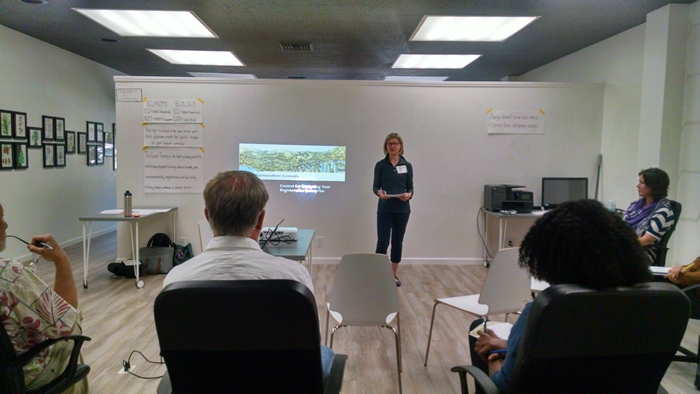
Between January and April, Santa Cruz Permaculture presented a series of four workshops entitled “Systems Change & the Next Economy: Regenerative Design for People & the Planet.” The series featured instructors with diverse backgrounds who are critically examining aspects of our economic, financial and monetary systems, as well as offering alternative models, inspiring examples and ideas for a new economic system that works for everyone.
My fellow Sustainable Solano co-workers had gone before me to the first three workshops, and on April 6 and 7, it was my turn. Led by Erin Axelrod and Kevin Bayuk of LIFT Economy, over the weekend we would “collectively explore the possibility of how we can redesign the economy to create regenerative outcomes of security, prosperity and a stable climate rather than outcomes of exploitation and inequity. By gaining an understanding of the design constraints of the ‘business as usual’ economy we will chart a pathway of transformation, using permaculture design principles, methods and ethics, to an economy that works for the benefit of all life. We will explore how to design enterprises and organizations that provide needed goods and services in ways that enhance and restore environmental and social prosperity.”
A tall order, but my group of around seven workshop participants jumped in with enthusiasm and curiosity.
We began by looking at the current problems: How currency use and certain economic activities have catalyzed a culture where humans don’t need anyone else — we only need money. (Or at least we think we don’t need anyone else.) This has resulted in lack of trust in people, only trust in money, and a laundry list of negative economic patterns (endless economic growth, greed, competition, prioritization of profit, commercialization, etc.) and skewed beliefs (“If I don’t have a leg up with inherited wealth, I’m not going to make it!”; “If you’re wealthy, that’s proof that you deserve more money!”; “If there’s a top category of wealthy people, there must be a bottom category”).
Erin pointed out that capitalism, as a system, has been good at suppressing alternatives and perpetuating itself, and making losers in the game. One point that I found fascinating was how humans are the only species with the concept of “unemployment,” and the idea that they/we have nothing to contribute. (Indeed, the squirrels scurrying around my backyard have endless work to do, within their functioning, natural ecosystem!)
So, now what?
Erin and Kevin argued that it is time to re-focus and think about how choices around business design and structure matter. What are models of creating businesses/organizations that don’t require passing on expenses to the end user? How can we find ways to meet our needs based on connection/community, and less on transaction/extraction? How can we design enterprises and organizations that provide needed goods and services in ways that enhance and restore environmental and social prosperity? Permaculture principles, which focus on “Earth Care, People Care and Fair Share,” provide the guiding star for this work. Is there a way to create an economy that works for the benefit of all life?
There are more questions than answers, but to try and arrive at some answers, Erin presented an interesting diagram:

Where we are now is at the top of the top curve, where the dotted line connects. “Business as usual” is the dotted line, which represents endless economic growth — but at the expense of others. The Hospice line represents activities that help the current system (with its inequities) to die off. The Midwifery line represents bringing in entirely new economic principles. And if all goes according to plan, we have a more equitable “Next Economy.”
There are lots of questions/issues around this graphic. Midwifery requires resources, which some organizations don’t have. Sometimes “hospice” is just keeping the bad from getting worse, and not actually working to stop dysfunctionality in the system. We then tried brainstorming examples of organizations that are practicing either “hospice” or “midwifery.” Patagonia would be one such example, as they are interested in repairing your (expensive) clothing, and not replacing it. They are trying to “hospice out” the “throw-away mentality” among consumers in the clothing industry and at the same time, “midwife” the idea of investing in fewer, higher-quality garments created in a fair trade system.
Another example that came up was TerraCycle. TerraCycle offers free recycling programs funded by brands, manufacturers and retailers around the world to help collect and recycle hard-to-recycle waste. But what I realized was that for TerraCycle to be completely effective, they need to be willing to go out of business. Some businesses that claim/work for good need to be so effective that they wouldn’t need to exist anymore.
We do have some organizations and people trying to do the right thing. But, when organizations/businesses are interfacing with the economy and trying to do the right thing, they hit a snag. Erin and Kevin call it the “Price Parity Paradox.” This means that when you are implementing a good/service and doing it “right” (equitable, environmentally sustainable, etc.), you end up with higher prices, making the thing inaccessible to those who might need it most. For example, let’s say I’m a community kitchen sourcing from small to mid-sized local farms (who practice sustainable agriculture) and paying fair prices for the ingredients. I’m also paying my staff – everyone from the dishwashers to the sous chefs – fair wages to produce nutrient-dense food. However, to maintain this business and be sustainable, my pricing needs to be at a certain level, which can only be afforded by wealthier people in the community. My products are too expensive and not accessible to certain populations who might need my nutrient-dense food the most (i.e. low income customers with health challenges).
All hope is not lost, however. Erin and Kevin presented some possible solutions to the Price Parity Paradox:
On the Demand Side:
This brought up more questions around perception of value: How do we get that shift where people are investing in things that benefit all life? Where are the people who are voluntarily ethical, and how did they get that perspective? How did they form value around certain things? Who are these self-selecting individuals opting in to pay more?
On the Supply Side:
Very few organizations are doing ALL supply and demand solutions to solve the Price Parity Paradox, but many are trying. It’s difficult because we are still operating within the constraints of the “business as usual” system. But let’s say you have an idea for an organization or business.
In our quest to design the Next Economy, we have circled back to the personal level. Here is another graphic that ties in personal purpose with an economic system:

As we wound down the weekend, I was reminded of the quote that Erin shared with us at the beginning of the weekend. It is from Adrienne Maree Brown, author of “Emergent Strategy: Shaping Change, Changing Worlds”:
Do you already know that your existence – who and how you are – is in and of itself a contribution to the people and place around you? Not after or because you do some particular thing, but simply the miracle of your life. And that the people around you, and the place(s), have contributions as well? Do you understand that your quality of life and your survival are tied to how authentic and generous the connections are between you and the people and place you live with and in?
⠀⠀⠀⠀⠀⠀⠀⠀⠀⠀⠀⠀⠀⠀⠀⠀⠀⠀⠀⠀⠀⠀
Are you actively practicing generosity and vulnerability in order to make the connections between you and others clear, open, available, durable? Generosity here means giving of what you have without strings or expectations attached. Vulnerability means showing your needs.
Changing a system is big work that requires years of travel down a long, long road. But by attempting to integrate some of these concepts into our lives, businesses and organizations, perhaps we can start to shift our culture. Perhaps we can have positive effects on other systems which are inextricably linked to our economic system, and perhaps someday we will be living within the “Next Economy.” Good luck!
The funding for Sustainable Solano’s team training at the “Next Economy” course at Santa Cruz Permaculture was provided by Solano Community Foundation through their NPP Capacity Building grants program. Community conversations are made possible through a grant from the Peaceful World Foundation. Thank you to both organizations!
The page you requested could not be found. Try refining your search, or use the navigation above to locate the post.